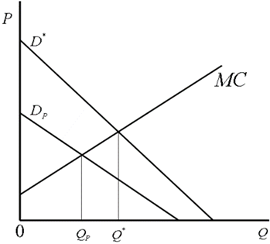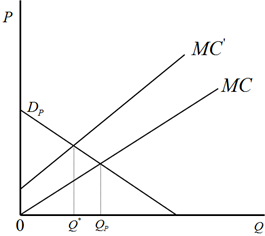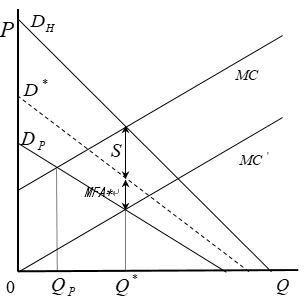2022. 12. 16. 15:52ㆍ공간농업, 농업공간/Multifunctional agriculture
농업의 다원적 기능은 긍정적 외부효과로 인해 시장실패를 발현한다. 시장실패는 비경합성, 비배타성으로 인해 소비자는 비용을 지불하지 않고 경제적 가치를 소비하게된다. 그렇지만 소비자는 이러한 행위를 알지 못한다. 다기능 농업은 농업의 다원적 기능을 경제효과로 전환하기 위한 활동이다. 다원적 기능의 가치를 다기능 농업을 통해 비용을 지불하고 소비하게 함으로 다원적 기능의 경제적 가치를 동시에 소비하게 하는 것이다.
2.1 Market failure and externalities of the Multifunctionality of agriculture
In a free-market economy, the market price is an essential determining factor for the producer, indicating the extent to which the production should continue (Kwon and Yun, 2004). A socially optimal level of production can be achieved when the output of the product is determined according to the market price signal. If distorted market prices are delivered to the producers, eventually, market failure will occur even though the producers made rational decisions based on the market information.
Products with the character of environmental material (environmental goods) can experience market failure through the distorted distribution of the market, and, unlike commodities that can be kept under total ownership, environmental material can be consumed without a payment (non-excludability), and its consumption cannot be stopped (non-rivalness) (Kwon, 2007). The multifunctionality arising from agricultural production activity has these characteristics too, thereby leading to market failure.
| Actual market production and demand (a) |
Positive external effect (externality) (b) | Negative external effect (externality) (c) |
 |
 |
 |
| - Landscape function - Historical and cultural function - Natural environmental function - Community activities - Ecosystem Conservation (biodiversity) - Carbon absorption |
- Pesticide spraying - Destruction farmland - Livestock manure emissions - Single-crop mass cultivation - Urbanization - Carbon emissions |
Figure 2.1 Market failure in agriculture due to multifunctionality
Source: Kwon (2007, p. 79, Figure 4-3).
Externalities are generated when the ownership lacks excludability, and, in agriculture, there are positive and negative externalities. If there is no externality, the social optimum is reached at point Qp , where the agricultural product demand curve Dp and the personal marginal cost curve MC intersect, as shown in Figure 2.1 (a). Figure 2.1 (b) indicates the positive externality caused by the Multifunctionality of agriculture. Agriculture generates not just agricultural products but also positive externalities, which can be utilized by anybody due to their non-excludability. As shown in the figure, the agricultural product should be produced in the amount of Qp if positive externalities were not taken into account, where the agricultural product demand curve Dp and the marginal cost curve MC meet, However, if the positive externalities DH were taken into account by society or consumers, the consumer could reach the social optimum at Q* , which is larger than Qpmentioned above . This situation leads to market failure.
Figure 2.1 (c) presents the opposite case to positive externalities, explaining the negative externalities. The farm’s marginal cost curve MC does not accord with the cost curve of the entire society, the social marginal cost curve moves to MC' , which is higher than the personal marginal cost curve due to the environmental destruction caused by the farm. In this situation, the farm’s desirable output is Qp , while the desirable output by the entire society is Q* , much less than Qp . This can hinder not only the socially optimal cost but also the multifunctionality and farm income as a result of people’s avoidance of rural villages due to the environmental destruction.
As shown, market failure occurs due to externalities in agriculture. If the negative externalities are more significant than the positive externalities, this market failure will rationalize the failure in the fairness of experience activities, tourism and social investment based on rurality. However, the continuous occurrence of rural villages’ negative externalities would cause a crisis for farms, rural villages and the country. Thus, the policy must maximize the positive externalities and minimize the negative externalities.
2.2 Market failure elimination through multifunctionality
Kwon (2007) theoretically explained the cause of market failure and proposed three methods to solve this problem in legal, institutional and administrative ways.
The most popular and straightforward way to remove the market failure of agriculture’s positive externalities is government’s direct subsidy based on the environmental improvement cost per unit area of agricultural production. Though the size of this kind of grant is hard to determine, there is ongoing research to establish a standard for the valuation of the Multifunctionality of agriculture.
Figure 2.2 shows a general theory for eliminating market failure through positive externalities. Where, Dp is the consumer demand curve excluding the Multifunctionality of agriculture, and DH is the demand curve including Multifunctionality of agriculture. If the externalities were taken into account, the demand and supply curve proposed earlier, makes supply Qp , not the optimal social supply Q* , which leads to a decrease in producers’ output and market failure. When the government pays a subsidy or direct payment with the per unit amount of the social welfare cost S to the producer, the marginal cost curve MC for the producer will move to MC' , and then the producer’s optimal output becomes the socially optimal Q* and the market failure can be eliminated.

Figure 2.2 General method of Market failure elimination

Figure 2.3 A new theory for Market failure elimination utilizing Multifunctionality of agriculture
Meanwhile, in this study, a new way of eliminating market failure is shown in Figure 2.3. In this figure, D* is the demand curve that farmers themselves can eliminate market failures through business activities such as the Multifunctional agriculture program when the overall market failure of agriculture by Multifunctionality of agriculture is DH . The market failure occurred because the existing method to eliminate market failure assumed that there was no compensation for the Multifunctionality of agriculture or positive externalities. Then, it is the theory that farmers can directly solve as much (or more/less) as MFA* corresponding to D* among the market failure S + MFA* from net production DP to net production with externality DH with an income activity that utilizes Multifunctionality of agriculture. This is a new theory, and it suggests that the consideration for compensation for S or MFA* can be solved with programmes such as Multifunctional agricultur. This is similar to the idea of paying an admission ticket and enjoying the scenery.
Multifunctional agricultur’s methods of converting multifunctionality into producer’s economic income include farm relaxation, autism treatment and care and rehabilitation for social misfits. These economic and social effects should exist as positive externalities derived from agriculture, and it is difficult to expect economic success in the region where the negative externalities occur. For instance, a devastated rural environment will not provide an excellent service for patients or elderly people who want recuperation. Furthermore, even some economic damages will occur when livestock faeces build up or pesticide spraying diminishes the will to consume agricultural produce.
Thus, the farmers are paid the economic income MFA* from Multifunctional agricultur activities in addition to the government subsidy S for social optimum Q* can be realized, Multifunctional agricultur will be one of solving methods and internalization methods to reduce or remove the market failure in agriculture by farmers themselves. This also eliminates the social distortion effect, moral laxity and the violation of free trade regulations.
From this view of point, Rural and agricultural activities must unfold in the direction of maximizing agriculture’s positive externalities, and the basic premise must be activities that improve rural village environments, including resource circulation, eco-friendliness and agricultural diversification.
출처 : Jung, Hyunhee
